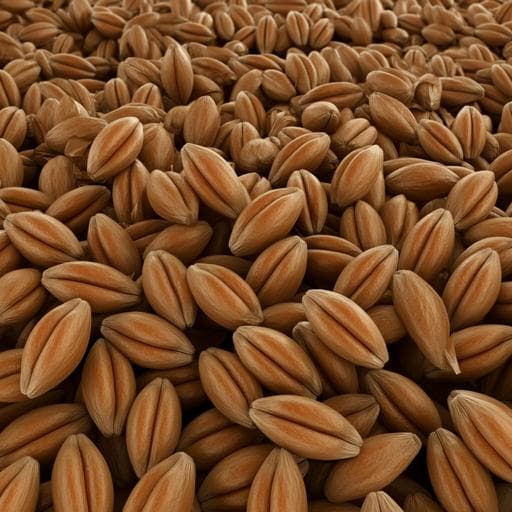
Food Science and Technology
Characterization of spring and durum wheat using non-destructive synchrotron phase contrast X-ray microtomography during storage
N. S. Indore, C. Karunakaran, et al.
This groundbreaking study by Navanth S. Indore and colleagues delves into the post-harvest losses of cereal grain storage, revealing that spring wheat varieties outshine durum varieties in resilience during storage. Using advanced synchrotron imaging techniques, the research offers critical insights to optimize storage practices and enhance breeding strategies for stronger crops.
~3 min • Beginner • English
Introduction
Global food demand is rising and cereals are staple foods worldwide, making reduction of post-harvest losses critical to food security. Storage losses in cereals range from ~10–20% in developing and 1–2% in developed countries, with high moisture content and fungal activity driving deterioration through respiration heat, moisture, and CO₂ production. Kernel microstructure influences susceptibility to spoilage, as pre-existing cracks or damage facilitate ingress of moisture and insects. While many macroscale studies have established safe storage limits and assessed quality under various abiotic and biotic factors, microscopic insights at high resolution are limited by conventional imaging constraints (low contrast for low-density phases, long scan times, non-selective wavelength). Differentiating spoilage from moisture and air in absorption X-ray imaging is difficult. This study addresses the gap by using synchrotron phase-contrast X-ray microtomography to characterize internal structures and deterioration processes in spring and durum wheat under high moisture storage, and to establish a methodology for non-destructive testing of cereal grains. Objectives were to: (1) gather structural feature information for dry and fungal-infected seeds in two wheat classes using phase-contrast imaging, and (2) develop a transferable synchrotron imaging and analysis workflow to support breeding, processing, and post-harvest storage recommendations.
Literature Review
Prior research on wheat storage spans macro- and micro-level investigations aimed at determining safe storage limits, reducing losses, assessing quality, and tailoring guidelines to local conditions. Macroscale studies use large setups to simulate interactions of moisture, temperature, humidity, insects, and fungi. Microscopic techniques (X-ray, hyperspectral, thermal imaging) have identified defects and specific fungi, but conventional systems face limitations such as sample preparation requirements, low contrast for low-density materials, time consumption, lower resolution, and non-selective wavelengths. Conventional X-ray imaging has been used to assess structural features (e.g., crease morphology linked to black point disease), but it struggles to distinguish spoilage, moisture, and air. Synchrotron phase-contrast X-ray imaging offers edge enhancement for low-density materials and has been applied in agriculture to study seed structure, soil, and plant systems. This motivates its application to post-harvest wheat storage to provide high-resolution, non-destructive internal structural data that can inform storage management and breeding.
Methodology
Materials: Certified seeds of Canada Western Amber Durum (CDC Defy, AAC Stronghold, AAC Spitfire) and Canada Western Spring Wheat (AAC Starbuck, AAC Brandon, Faller) were procured (SeCan, Niverville, MB). Storage experiment: Five-hundred-gram samples of each variety were conditioned to 17% moisture content (wet basis) by adding distilled water in triplicate. Samples were stored in 1 L airtight glass jars at ambient 22–25 °C for up to 5 weeks. Moisture content was verified 24 h post-conditioning by oven drying 10 g at 130 °C for 19 h and reconditioned as needed to 17 ± 0.5%. Imaging also included seeds stored frozen at −18 °C after 5 weeks to assess any structural changes due to freezing. Sample preparation for SR-µCT: 15–20 kernels per variety were randomly selected from two replicate jars and placed in a plastic tube (replicate 1 at top slices, replicate 2 at bottom), with ends sealed to prevent dehydration. The tube was mounted on a rotation stage and aligned within the beam field of view. Synchrotron phase-contrast micro-CT acquisition: Experiments were conducted at the BMIT-BM beamline (Canadian Light Source). Filters: Al 0.800 mm and Mo 0.076 mm before the monochromator to produce a filtered white beam of ~20 keV. Detector: PCO Edge 5.0, AA-40, with LuAg 500 scintillator, yielding 3.6 µm voxel size. Geometry: Sample-detector distance 5 cm for edge-enhanced phase contrast. Projections: Rotation 0–180° with 0.06° steps; each of 13 vertically tiled slices comprised 3000 projections. Preprocessing and reconstruction: Dark and flat field correction (averaged before/after scan). Single-distance phase retrieval using Paganin’s method with UFO-kit (Tofu 0.12). Ring artifact removal and reconstruction followed by vertical stitching of 13 slices using ez_helper in UFO-kit to find overlap. Data were binned 4×4×4 in Fiji (2.9.0) to reduce size to <4 GB per dataset. Segmentation and analysis: In Avizo, interactive thresholding segmented seeds from air; morphological operations (opening, closing, fill holes) cleaned boundaries. Label analysis quantified seed volume, dimensions, and porosity (volume fraction). For detailed component analysis, three control seeds were randomly selected per variety and the three most spoiled seeds after storage were selected by visual inspection. In ORS Dragonfly (2021.3), separate ROIs were created for germ, air space/cracks, change due to spoilage, and whole seed using global threshold ranges based on histograms. Labeled voxels were measured to compute volumes for each component. Quantitative datasets for seed volume and porosity used n=20 per condition where reported; error bars indicate standard deviation of the mean.
Key Findings
- Visual assessment after 5 weeks at 17% mc showed greater deterioration in durum wheat than spring wheat; AAC Spitfire and CDC Defy (durum) were heavily affected, while AAC Stronghold was less so. In spring wheat, AAC Starbuck and AAC Brandon showed more anomalies than Faller, whose kernels were largely sound.
- SR-µCT revealed more pre-existing cracks in control samples of all three durum varieties than in spring controls; endosperm damage was most pronounced in AAC Spitfire and CDC Defy.
- Deterioration in durum became evident by 3 weeks and increased by 5 weeks; in spring wheat, notable changes were observed mainly at 5 weeks.
- Freezing (−18 °C) after 5 weeks did not alter internal structures further; frozen samples’ airspace and volume metrics closely matched 5-week values, supporting the hypothesis that freezing preserves structure for delayed imaging.
- 3D segmentation quantified deterioration: all three durum varieties had higher segmented spoilage volumes than spring varieties. AAC Spitfire had the highest spoilage volume, followed by CDC Defy and AAC Stronghold.
- Germ volumes were generally higher in durum than spring; deterioration often initiated near the germ and crease and then spread along cracks.
- Seed volume analysis showed larger variation among durum seeds; CDC Defy had the highest seed volume among all varieties, whereas AAC Starbuck had the lowest.
- Air space/cracks (porosity) increased with storage time; AAC Spitfire had the highest percentage air space, Faller the lowest. Frozen samples’ porosity was similar to 5-week samples.
- Histogram analysis (gray-value distributions) showed leftward shifts near the endosperm peak in deteriorated samples indicative of fungal infection; the largest shift occurred in AAC Spitfire, minimal in AAC Stronghold and spring varieties.
- The study successfully differentiated and segmented low-density phases (airspace vs. spoilage) and measured kernel porosity non-destructively, which conventional absorption X-ray methods struggle to achieve.
Discussion
The study demonstrates that internal microstructural features, especially pre-existing cracks and crease morphology, strongly influence wheat’s susceptibility to storage-related spoilage at elevated moisture. Cracks propagating from the crease through the endosperm, and sometimes breaching the seed coat, create pathways for moisture ingress and fungal colonization. Phase-contrast SR-µCT enabled clear visualization and segmentation of low-density features, revealing that deterioration typically initiates at the germ near the crease and follows damaged regions, explaining early loss of seed viability. The comparative results align with the hypothesis: spring wheat varieties generally withstood high-moisture storage better than durum varieties over 5 weeks, and freezing stabilized sample structure for deferred imaging without introducing artifacts. Quantitative metrics—spoilage volume, porosity (air space/cracks), seed and germ volumes, and histogram shifts—provide objective indicators of deterioration that correlate with visual observations. These findings underscore the need to assess and select sound, dry grain prior to long-term storage and highlight varietal differences within classes that can inform storage management, processing (e.g., milling adjustments), and breeding priorities (tighter crease, less brittle endosperm). The methodology offers a robust, transferable approach for monitoring microstructural deterioration in storage studies and overcomes limitations of conventional X-ray absorption imaging in distinguishing spoilage from air.
Conclusion
This work provides the first high-resolution, non-destructive SR-µCT phase-contrast characterization of internal structural deterioration in spring and durum wheat during high-moisture storage, along with a validated workflow for imaging, reconstruction, segmentation, and quantitative analysis. Key contributions include: (1) demonstrating greater susceptibility of durum wheat (especially AAC Spitfire and CDC Defy) to spoilage than spring wheat under 5-week storage at 17% mc; (2) showing that freezing at −18 °C preserves internal structures, enabling flexible imaging logistics; (3) quantifying deterioration via segmented spoilage volumes, porosity, and histogram shifts that serve as objective spoilage indicators; and (4) identifying germ and crease regions as initial loci of deterioration. The data inform breeding (improved crease features, less brittle endosperm), storage management (screening and selecting sound kernels, model development), and processing adjustments. Future research could apply machine learning to automate extraction of crease opening/depth and other microstructural traits across wheat classes, extend the approach to other cereals, and correlate microstructural metrics with biochemical and nutritional changes.
Limitations
Related Publications
Explore these studies to deepen your understanding of the subject.







